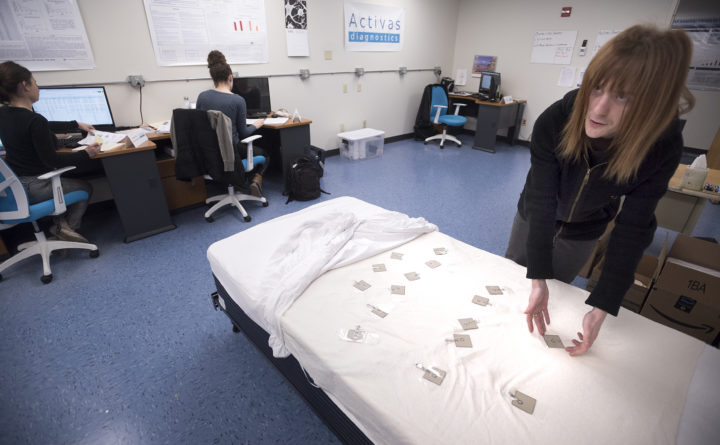
The strangest part of Activas Diagnostics’ office space located in the UpStart Center for Entrepreneurship in Orono is the twin bed in the middle of the room.
Covered with a hypoallergenic white sheet, the bed itself looks nothing out of the ordinary. However, a look under the sheet reveals a thin layer of fabric with something resembling laminated plastic squares attached to it.
The company is partly funded by the Maine Technology Institute. Last June, the National Institutes of Health awarded Abedi and Hayes’ team $1 million through the Small Business Innovation Research (SBIR) program to continue updating the product and perform market research.

The sensors are about a millimeter thick, and are spread out on the sheet to measure movement in different parts of the body.
Currently, someone who has already noticed signs of Alzheimer’s goes to the doctor, who recommends that the patient visit a sleep lab. There, specialists observe the patient and study sleeping patterns to collect the same data that Abedi and Hayes, a professor of psychology, aim to collect with their device.
Since they do not replicate a natural sleeping environment, Abedi said, the results can be inaccurate.
“But if you take our devices home, you’re sleeping in your own bed, on your own mattress. There are no cameras and no uncomfortable wires,” he said. “We hope with this system we not only significantly reduce the cost as compared to sleep labs, maybe by a factor of 10, but also provide a little more comfort to people who are dealing with this issue.”

Activas employees, some of whom are UMaine graduate students and postdoctoral researchers, are conducting a clinical trial with patients between the ages of 65 and 85 to determine how effectively SleepMove can detect symptoms of early cognitive impairment. They have 20 patients signed up and are aiming to study 100 to get reliable results. That process will take up to a year, Abedi said.
A team from Activas sets up the device at each participant’s home. The fabric with the sensors is placed between two fitted hypoallergenic mattress covers on the participant’s mattress. Activas employees set a small blue box with wires under the bed and push “start.” The employees bring the device back to their office for analysis after it collects two nights of sleep movement and breathing data.
Trial participants also wear a clinical-grade, sleep-wake detection watch, which Chris Gilbert, clinical research study coordinator at Activas, said sleep labs also use.
Abedi hopes that analysis of SleepMove data will be able to determine loss of cognitive function with more than 95 percent accuracy.
Activas has also been conducting market research as it tests out its product.
“We are preparing for the workforce need that will arise very soon,” Abedi said.
They work with UMaine’s Office of Innovation and Economic Development, which provides university spinoff companies with coaching and other resources they need to launch successful businesses.
Activas’ contribution to the Bangor-area economy goes beyond creating jobs, said Renee Kelly, UMaine’s assistant vice president for innovation and economic development.
“They’re also a great role model for faculty and students who would like to commercialize their research,” she said. “It’s our goal to see the research activity that happens spin off into new companies or products. This is a great example of that happening.”
This article originally appeared on www.bangordailynews.com.







